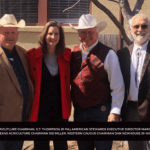R-CALF United Stockgrowers of America
“Fighting for the U.S. ! Cattle Producer”
For Immediate Release Contact: R-CALF USA CEO Bill Bullard
December 16, 2011 Phone: 406-252-2516; r-calfusa@r-calfusa.com
8 Days of Opposition to USDA’s Proposed Mandatory Animal Identification Rule: Part III of VIII-Part Series
Billings, Mont. – As promised, R-CALF USA has launched an 8-day series of news releases to explain in detail many of the reasons our members vehemently oppose the U.S. Department of Agriculture (USDA) Animal and Plant Health Inspection Service’s (APHIS’) proposed mandatory animal identification rule titled, Traceability for Livestock Moving Interstate (proposed rule).
With this effort, R-CALF USA hopes to bring to light many of the dangerous aspects associated with the proposed rule that R-CALF USA described in its voluminous comments submitted to APHIS on Dec. 9, 2011. Click here to view the entire 41-page comment submitted by R-CALF USA, which includes all of the group’s citations to specific references that are removed from this news release to save space.
Part III: The Proposed Rule Would Cost the U.S. Cattle Industry Hundreds of Millions of Dollars
C. APHIS Grossly Understates the Economic Cost of the Proposed Rule that Will be Borne by U.S. Cattle Producers
- 1. A three-year study shows the proposed rule will cost U.S. cattle producers hundreds of millions of dollars, if not billons of dollars
USDA data show the 2010 U.S. calf crop was 35.685 million head and the U.S. commercially slaughtered 34.249 million cattle in 2010. (EXHIBIT 11, p. 19) Based on the assumption that all of those cattle had to be moved at least once in 2010 – from herd of origin to grass or backgrounder, or from herd of origin to feedlot and/or slau! ghter plant, respectively – there was a potential for all those cattle to be moved in interstate commerce and to be subject to the proposed rule’s requirements (it is noted the requirement for indentifying feeder cattle would be only temporarily delayed under the proposed rule). Thus, there was the potential in 2010 for nearly 70 million head of cattle to be required to be individually identified if the proposed rule were fully implemented.
A study presented to the U.S. International Trade Commission (USITC) in 2007 by Kris Ringwall, Ph.D., Director, Dickinson Research Center Extension and Livestock Specialist, North Dakota State University (NDSU), that involved the tagging of 14,432 calves during the three-year period 2004-2006, concluded that the cost working each calf, tag placement and documentation was $7.00 per calf. (EXHIBIT 12, p. 2) In addition, Dr. Ringwall’s three-year project determined tha! t the tagging of calves was costly to producers because of shrink, which he defined as “weight loss while handling calves.” (EXHIBIT 12, p. 2) Dr. Rinwall stated in his testimony:
When we’ve measured shrink in the cattle we have worked during the project, we estimate up to $10 to $20 in lost income potential per calf, regardless of the management activity applied. (EXHIBIT 12, p. 2)
Based on Dr. Ringwall’s findings, the cost of tagging and documenting calves, excluding the cost of the tag itself, and the cost of the income lost due to shrink, ranged from $17.00 per head to $27.00 per head in 2006 or 2007 dollars. Based on information and belief, that cost in 2010 dollars likely is as high as $30.00 per head, if not higher. However, applying Dr. Ringwall’s 2007 findings to all cattle – cows, bulls, and calves – the likely cost of the proposed rule to U.S. cattle producers ranges from $1,190,000,000 ($1.2 billion) to $1,890,000,000 ($1.9 billion) (70 million head of cattle multiplied by $17.00 per head and $27.00 per head, respectively). Even if only the cattle moved to slaughter in 2010 were considered, the cost to U.S. cattle producers would be $924,723,000, or about $920 million (34.249 million head of commercial slaughter cattle multiplied by $27.00 per head).
Applying Dr. Ringwall’s findings to APHIS’ assertion that “[a]pproximately 20 percent of cattle are not currently eartagged as part of routine management practices” (see 76 Fed. Reg., 50097, col. 1) and based on the assumption that APHIS used the Jan. 1, 2011, U.S. cattle and calves inventory number of 92,582,400 head, it would cost U.S. cattle producers a high of nearly $500 million to tag the 20 percent of cattle not already tagged (20 percent of 92,582,400 cattle equals 18,516,480 cattle multiplied by $27 per head).
Using APHIS’ data relied on in its supporting document, only 3.1 million of the 35.685 million head annual calf crop is tagged with official identification. Therefore, the cost of tagging the remaining 2010 calf crop would range from $554 million to $880 million.
Thus, based on an actual study of tagging actual cattle – not on a study of available literature upon which APHIS relies – the cost to U.S. cattle producers to comply with the proposed rule will likely be hundreds of millions of dollars, if not billions of dollars. APHIS’ upper cost estimate for the proposed rule of only $34.3 million (see 76 Fed. Reg., 50097, cols. 2, 3) is based on a complete lack of understanding of the U.S. cattle industry, and it grossly understates the cost that U.S. cattle producers actually will bear if USDA does not immediately withdraw the proposed r! ule.
R-CALF USA encourages readers to share this information with their neighbors, state animal health officials, and their members of Congress.



